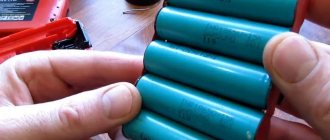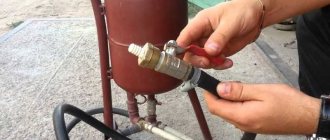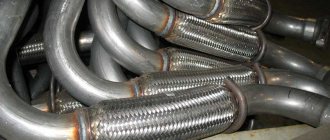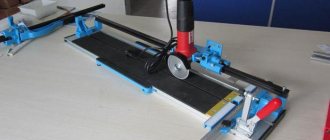In order to convert a screwdriver to a lithium battery, you will need the unit itself, batteries and a simple arsenal of tools. The feasibility of transformation is caused by the performance characteristics of lithium-ion models.
Their electrical density significantly exceeds that of nickel-cadmium batteries. Less weight and longer operating time are noted. In addition, Li-Ion batteries do not have such a disadvantage of Ni-Mh analogues as the memory effect. Accordingly, they can be charged at any time, regardless of the current level.
But Li-Ion batteries perform worse in cold weather. Already at a temperature of 10 C they begin to discharge quickly. If the work mainly takes place in open space, then it is better to do without transformation. If you have basic skills, you can replace the screwdriver with lithium batteries yourself.
Converting a screwdriver to be powered from a wall outlet
In the household of a modern person, a screwdriver is not a rare tool; in fact, this tool is analogous to an electronic drill. The advantage of this type is considered to be autonomous power supply
from a portable battery embedded in the bottom of the handle. The battery needs to be charged from time to time from the mains through a special charger; after long-term use, the battery breaks down, requires replacement, and they are expensive. Therefore, many users are thinking about how to recycle a cordless screwdriver so that it works from a 220-volt network.
View of 1st option
From time to time, consumers decide that they need to convert a screwdriver into an ordinary electric drill powered from a power outlet. The question arises of how to do this with the least amount of time and money. If you have some knowledge of electrical engineering and practical abilities, then powering a screwdriver from a 220V network is not difficult. There are several methods using different devices to convert electricity to the appropriate form for rotating the screwdriver motor.
Conversion with standard battery and charger
Converting a cordless screwdriver to a mains-powered one in this case implies that the circuit is assembled on the basis of a standard charger. The following materials will be required:
- Charger;
- Accumulator battery;
- 2-3 meters of flexible stranded copper wire, with 2 conductors, cross section 2.5-4 mm2;
- An ordinary set of tools and consumables, a soldering iron, solder, insulating tape or heat-shrink tubing of the appropriate diameter for the wires. To disassemble the screwdriver you will need a screwdriver, side cutters and a mounting knife for cutting and stripping wires.
The sequence of operations in the process of converting a screwdriver into a network one:
- Remove the cover from the charger body;
- The ends of the wire are soldered to the output contacts of the charger board, which are connected to the battery during charging, observing the polarity. A core with reddish insulation goes to the “” terminal, with blue insulation – to the minus terminal;
Charger board
- Polarities can be found by the inscriptions on the board or product body. To be reliable, you can turn on the charging and use a multimeter to measure the 12 V output and find the contacts by polarity;
- Galvanic cells are removed from the battery case;
How galvanic cells are removed from the battery compartment
The charging wire is connected to the contacts inside the battery case, observing the polarity.
Thus, the screwdriver is converted into a network one. When the device is plugged into the socket on the input circuit of the screwdriver
a corresponding voltage of 12 or 18V constant current will be supplied.
Maintaining polarity is recommended, but not mandatory. the screwdriver chuck is practically reversed
.
Fundamentally! The terminals on the charger board are usually made of brass alloy; they must be soldered to the copper wires with acid solder or removed altogether, and the wires must be soldered onto the tracks of the printed circuit board.
Before soldering, holes are made in the battery and charger housings through which the wire is pulled. To fix it more rigidly within the boundaries of the body, you can tie it into a knot and wind electrical tape so that the diameter of the winding exceeds the Ø of the hole.
Precautionary measures
There are several safety precautions you should be aware of before using a cordless power tool:
- The device can be stored at a temperature not lower than 0 degrees;
- Do not allow liquid to come into contact with the battery;
- The battery can only be charged at a temperature of 10-50 degrees Celsius;
- You cannot charge a damaged battery.
Quite often, owners of cordless screwdrivers are faced with situations where the battery stops working. In such cases, you will have to connect the device to the network. However, before this, you need to find out how to convert a screwdriver to power from a 220V network and what needs to be done for this.
Connecting to a computer
Remote power supplies can be designed based on the power supply from a laptop or computer.
From a computer power supply
As a rule, craftsmen use AT-type blocks. They have a power of about 350 Watts and an output voltage of about 12 Volts. These parameters are sufficient for normal operation of the screwdriver. In addition, all technical specifications are indicated on the case, which greatly simplifies the work of adapting the power supply to the instrument. The device can either be borrowed from an old computer or purchased at a computer store. The main advantage is the presence of a power switch, a cooling cooler and an overload protection system.
Next, the sequence of actions is as follows.
Disassembling the computer case. Elimination of power-on protection, which consists of connecting the green and black wires that are present in the specified connector. Working with a MOLEX connector. It has 4 wires, two of which are unnecessary. They need to be cut off, leaving only yellow for 12 Volts and black for grounding. Soldering to the left wires of an electrical cable
Particular attention should be paid to insulation. Disassembling a screwdriver. Connecting the instrument terminals to the opposite end of the electrical cable. Tool assembly. It is necessary to ensure that the cord inside the screwdriver body is not twisted or pressed too hard.
Laptop charger
The power source for the screwdriver can be a charger from a laptop. Its modification is kept to a minimum. It should be noted that any 12-19 Volt device is suitable for use. The algorithm of actions is as follows.
- Preparing the output cord from the charger. Using wire cutters, cut off the connector and strip the ends of the insulation.
- Disassembling the tool body.
- The bare ends of the charger are soldered to the screwdriver terminals, observing polarity. You can use special plastic ties, but professionals advise not to neglect soldering.
- Isolation of connections.
- Assembling the body of a power tool.
- Performance testing.
Battery cell connection methods
The block that accumulates energy can be assembled in different ways. There are three types of assembly :
- soldering;
- spot welding;
- cassette.
You need to solder as quickly as possible, so you need a powerful soldering iron of about 100 W. Lithium batteries are afraid of overheating, so they should not be heated for a long time; high temperatures will cause damage. If you lack experience, you should resort to the services of a professional.
The technique of connecting elements into a block using spot welding is considered the best. A master who has a special welding machine can do the job better.
Special cassettes are considered not a very reliable method . The resulting contacts have significant contact resistance, which will quickly begin to deteriorate at high current.
The elements are connected in series, then the voltage is summed, but the capacitance value does not change. Batteries connected in series do not all fail at the same time, so in some cases, from two batteries of a screwdriver, you can restore one working battery by selecting serviceable ones. But we must keep in mind that it will not last long. Therefore, experts advise resorting to such repairs in rare cases.
Additional Information
The above-described principle of powering a screwdriver with a dead battery is far from the only one. The instructions show the simplest method. As you can see, the presence of a large external transformer spoils the entire aesthetics and practicality of the instrument, which, according to the original idea, should be mobile and lightweight.
A special board based on the IR2157 chip will help make the power supply circuit more professional. The master will only need to use a transformer winding, a capacitor and a diode bridge in the board that correspond to the parameters of a particular screwdriver.
Thanks to the compact dimensions of the board, it can be neatly placed in the battery pack case. Below is an auxiliary video, the author of which assembles a board on the IR2157 chip with his own hands, and also powers a cordless screwdriver with its help.
If you can’t assemble this board yourself, it doesn’t matter. IR2157 can be purchased at any radio market. All that remains is to modify the transformer and diode bridge with capacitor.
Features of the screwdriver device
The screwdriver and its main parts: 1 – chuck; 2 – torque regulator; 3 – rotation direction switch; 4 – button to start and stop the electric motor; 5 – battery pack housing; 6 – motor shaft speed switch; 7 – latch for holding the battery with the tool
Information for products. The emergence of a conventional battery device for quick installation of threaded connections was facilitated by the appearance of compact cylindrical batteries. In 1982, the first sample was presented at an exhibition in Dresden (GDR). Then they looked at the interesting homemade product and admired it. I was confused by the price. It reached 500 German marks (GDR). Then it was believed that not every user would dare to buy something like this for permanent work.
Few could have imagined that within 20 years the price of such an instrument would be quite acceptable for production. Later, home craftsmen will begin to buy them to mechanize work at home.
To remodel the instrument, you will have to disassemble it, so it is useful to know the internal structure.
Internal structure of the screwdriver: 1 – electric motor; 2 – power button combined with reverse; 3 – battery pack; 4 – gearbox; 5 – torque adjustment clutch; 6 – cartridge
To disassemble, you need to unscrew the screws that connect the two halves of the housing to form a single whole. You will have to put the screwdriver blade end-to-end and open the halves. All installation is performed on the part into which the screws are screwed.
During assembly, it is necessary to control the position of the protruding elements. Additional methods may be required to secure moving parts.
Do-it-yourself power supply for a screwdriver
In order to convert a cordless screwdriver into a mains-powered one, you must first make a step-down transformer. It is made on the basis of the one that was used in older TV models. When powering the screwdriver from an electronic transformer, the latter must be designed for a power of 160 W. In order to prepare one that is necessary for a screwdriver, you need to do the following:
- The prepared transformer must be disassembled.
- The secondary winding must be removed completely.
- You need to wind ten turns.
- Now the transformer is ready, all that remains is to assemble it.
- Next you need to take measurements. Now it is connected to the network and the voltage obtained on the secondary winding is measured. Now the number of turns, which in this case is ten, is divided by the voltage now measured. The resulting value is multiplied by the voltage required for the tool and the number of turns required is obtained.
- Now, having disconnected the transformer from the network, it is disassembled again and the required number of turns is wound. Then it needs to be collected.
For winding, take a wire whose cross-section is equal to 1 square. mm.
After the current passes through the transformer, the output will be alternating voltage. The power supply circuit for a screwdriver provides that in order to get a constant voltage from it, you will need to make a diode bridge. It is made using diodes on radiators rated at 20 V and 10 A.
The converter made in this way is placed in a housing. Its output will produce the voltage that is necessary for the screwdriver to operate. The input voltage will be 220 V.
The wires coming from the power supply are connected to the contacts through which the instrument is powered.
Such a power supply for a mains-powered screwdriver is usually mounted in a housing where the battery previously was.
Why redo it?
A cordless screwdriver has many advantages over a corded device. It can be used even where there is no electricity supply; you can tighten fasteners in hard-to-reach places; the master’s movements are not limited by the length of the wire or extension cord. In short, this option is often chosen for household work.
But the cordless screwdriver is limited in operating time by the capacity and quality of the installed battery. You can use it until she sits down. Moreover, if the battery fails and stops holding a charge or cannot be charged at all, then the screwdriver itself will not work. You need to either replace the battery or convert it into a network version. In some cases, replacing the battery is completely impossible. And a new one costs almost the same as a new device. Of course, in this case, most people will decide to buy a new model of screwdriver.
A new battery for a screwdriver sometimes costs as much as a new tool
On a note! The average life of a battery in a screwdriver is about 3 years. After this it needs to be changed.
But, as practice shows, in some cases it is easier and cheaper to convert a cordless screwdriver into a 220 V powered one. You will give the tool a new life and save money. The only limitation that such an updated screwdriver will have is the need to plug it into an outlet before use. But it is possible not to interrupt work while recharging the battery.
Other power supply methods
Block inside
The solution to the problem “is it possible to connect a screwdriver via a charger” can be an alternative option for powering the screwdriver - installing a power supply in the empty housing of the tool’s power supply unit.
Before starting action, it is necessary to prevent overheating of the unit, for which purpose holes are pre-arranged in the housing that will ensure air movement and heat removal. With this improvement, it is advisable to reduce the time of continuous operation of a screwdriver to 15 minutes.
A ready-made block is purchased and selected according to the body size and technical parameters. The pulse version of the module is most suitable for use; it is small-sized and lightweight. The use of domestically produced modules from the last century is not recommended - they have large volumes and low efficiency.
Unusable batteries are removed from the stock and a power supply is placed in their place. The contacts are energized and the housing is closed. The assembled hybrid gadget is ready to work from the network.
- The wires can be extended for convenience.
- It is necessary to monitor the quality of the assembly: the structure should not be able to touch metal elements, otherwise a short circuit will occur. It is best to leave some space between the transformer and the board, which will have a positive effect on cooling.
- If any parts of the structure become very hot, it is possible to install modules that remove excess heat or install ventilation slots.
On your own
For users with special knowledge and skills, the problem “is it possible to power a screwdriver from a charger without special means” will not be difficult, because Assembly of the nutritional unit is possible with your own hands. Instead of damaged elements, a power module assembled according to the circuit is inserted into the case. The outgoing voltage is monitored, the wires are energized, and the housing is locked.
Advice: the circuit may require additional load; this can be achieved by including a 15W light bulb in the system, which will also provide illumination.
A computer module will also work
Another solution to the problem of powering a screwdriver is to mount it to a computer power supply. This option applies to modules that are equipped with a mechanical switch lever. The positive aspect is that the unit is cooled by a cooler and is protected from exaggerated loads by a built-in special system.
Operating rules
Before using a screwdriver, each person should familiarize themselves with the rules of its operation. There are several recommendations that must be followed:
- You only need to work in a stable position, watching the position of your arms and legs;
- if you have to screw in screws at a height, it is better to use a stepladder;
- Every half hour you need to take a break so that the instrument cools down;
- When drilling, you need to secure the workpiece so that it is stationary.
Another important rule that must be followed is regular checking of all components. Before use, you should inspect the screwdriver to ensure there is no damage.
Various options for remote power supplies
A remote-type power supply for a screwdriver can be made from the following devices:
- from a computer power supply;
- using a laptop power supply;
- from charging a car battery;
- from an inverter welding machine.
Remote power supply from a power supply from a computer or laptop
In this case, to make a power supply for a screwdriver, you will need a power supply from an “AT” format computer with a power of 300-350 W. The current strength at its 12 V output will be about 16 A, which is quite enough to operate a medium-power power tool. The part can be removed from the old system unit or purchased, for example, at a computer store. Moreover, it is already equipped with a power button, a cooling fan, and overload protection.
The main operating characteristics of a computer power supply are contained on the plate of its case.
The work of adapting the device to work together with a screwdriver is carried out in the following sequence:
- disassemble the computer power supply case;
- remove the switch-on protection by connecting for this purpose the green wire with any of the black wires included in this connector;
- then the wires that are not needed are cut off from the MOLEX connector: only the yellow (+12 V) and black (ground) wires are left;
- solder one end of the cord to the yellow and black wires;
- disassemble the screwdriver;
connect the second end of the wire from the power supply to its corresponding terminals;
Reassemble the tool in reverse order.
The end result will be equipment similar to the one in the photo below.
Using a laptop charger as a power source for the tool you are using is a very simple option. In this case, no special modifications are required. A charger with an output voltage of 12 to 19 V is suitable.
The device is modified as follows:
- cut off the connector from the output charging cord with pliers;
- expose the ends of the wires;
- disassemble the screwdriver;
- solder the charging wires to the corresponding contacts of the tool;
- assemble power tools;
- check its performance.
You can also connect the cord to the screwdriver via a battery. The batteries are first removed from it, and holes are made in the case for the power cable.
The ends of the cord are connected to the battery terminals.
Reworking charging a car battery and an inverter welding machine
Converting a charger from car batteries into a charger for a screwdriver is done in a similar way to upgrading a power supply from a laptop. In the car market, you will need to purchase not a switching power supply, but an analog-type device (if you don’t have an old one at home that is not in use) with the ability to manually regulate the current and voltage at the output when charging the batteries. Such a device is inexpensive. Its appearance is shown in the photograph below.
The rework algorithm is as follows:
- select 2 stranded wires of the required cross-section;
- special contact clips (“crocodiles”) are attached to one end of each of them, and 2-3 cm of insulation are removed from the remaining ones;
bend the stripped ends into a hook shape;
disassemble the screwdriver;
the bent ends will be connected to its contact terminals, soldering them with a soldering iron or tightening them with plastic clamps (ties);
electrical connections are well insulated to prevent short circuits;
assemble the power tool, making sure to check its functionality afterwards.
In order to correctly connect the converted tool to charging, the “crocodiles” are marked in any acceptable way, for example, with a certain color or inscriptions (“+”, “-”).
Creating an external power source from an inverter welding machine is a more complex operation compared to the modification methods discussed above. Due to the discrepancy between the output currents of the unit and the required value, it will be necessary to change the design of the equipment. To do this, you need to carry out related calculations. Here you can’t do without good knowledge of electrical engineering.
The circuit of a corded screwdriver is fundamentally no different from its cordless counterpart. For this reason, reworking the power tool itself consists of carefully connecting it to an external power source or upgrading the drive. In addition to the options discussed, there are many other ways to convert a screwdriver to work from the network. For this purpose, they even use parts from old tube TVs. But in all cases, you should remember about safety - the simplest option is to use fuses.
How to power a screwdriver while maintaining its autonomy
There are situations when you have to work outdoors or indoors where there is no electricity. In such situations, you need to power the screwdriver yourself to make it work. There are several ways to do this.
Replacing old elements
Most often, people are unable to use a cordless tool because the battery has failed. The easiest way to solve this problem is to connect a new battery. It is recommended to use the same batteries that were previously installed in the screwdriver.
Important! When replacing the battery, the polarity of the components must be observed. This will prevent a short circuit.
Connecting to a car battery
Another way to quickly power the tool is to use a car battery. This is done as follows:
- Take three wires from the cigarette lighter and strip them of 3-4 cm of insulation.
- Connect the wires. They are connected to the battery terminals and to the screwdriver.
- Tighten the connections with clamps or insulate with electrical tape. It is necessary to wrap them in such a way as to hide all metal parts.
After this, you need to check whether the tool works.
Connecting to an external battery
If you need to use a screwdriver, you can connect it to an external battery. A battery from any unnecessary UPS is ideal for this. To connect the instrument, do the following:
- Cut the screwdriver cable and clean the contacts on it.
- Connect the cord to the battery terminals.
- Check the connection is secure.
- Insulate connections.
After finishing work, the screwdriver must be disconnected from the battery.
Fault prevention
Batteries are made of several elements put together, which do not fail simultaneously, but in parts. To determine the broken part of the battery, it is necessary to fully charge it and allow it to work at full power until discharged. After that, disassemble and measure the voltage of each individual element.
Parts on which the voltage will be absent or inferior to other elements must be completely replaced. Repairs are carried out using a soldering tool. All battery cells are soldered together with the same wire strip that originally connected the parts.
The process of dismantling the battery case
Before the screwdriver is converted to lithium batteries, it is disassembled. The tool body can be connected using :
- glue;
- locking rivet devices;
- screws.
The most difficult to remake is a model with a glued body. It is carefully disassembled along the joining seams, tapping it with a hammer with a soft plastic head. If you accidentally damage the halves of the box, it will be difficult to assemble, and in the future it will be problematic to work. The case is easily disassembled, connected by latches and self-tapping jumper screws .
How to convert a cordless screwdriver to work on a 220 Volt network
Craftsmen have come up with several ways to convert a screwdriver to work from an electrical network. They all involve providing the motor with the required supply voltage using an intermediate source or converter.
Table: power supply options for a corded screwdriver
| Power supply | Advantages | Flaws |
| Complete screwdriver charger. |
| The charger takes up space on the desk. |
| A ready-made power supply placed in the housing of an old battery. |
|
|
| A homemade power supply placed in the housing of an old battery. |
|
|
| External power supply | An easy modification. |
|
| Computer power supply |
|
|
Assembling the finished battery
First, they clean all parts of the case and think about where to place the new charging unit. The converted battery will be much smaller in size than the original one, so it must be well secured inside the case. If this is not done, then due to vibration during operation of the tool, the unit will fail after a short period of time. For fastening, you can use Moment glue or sealant . Wires are soldered to the assembled block. When working, follow the connection diagram. Wires with a cross section of 4 mm2 are soldered to the batteries. To prevent the parts from touching each other, use heat shrink tubing. The terminal block with soldered wires is installed in its original place. If there are no grooves for it in the housing, it needs to be secured. The assembly is connected to “plus” and “minus”.
Assembling the protective board involves connecting all parts of the battery pack. Be sure to check the reliability of the placement .
Battery cells can be connected in different ways
Glamorous trees for boudoir
The next year of the white metal Ox means decoration in white and pastel colors. Nothing red or flashy!
PHOTO: YouTube.com For a glamorous decoration, you will need ready-made Christmas trees from Fix Price, which consist of a conical frame and tinsel, as well as a feather and fluff boa, which can be found in the same store
The bright tinsel will have to be removed - you only need a cone. And then it’s a matter of literally a few seconds: wrap the cone with a lady’s jewelry and secure the ends.
PHOTO: YouTube.com Window sill, mantelpiece, festive table, table in the bedroom - this decor will look unusually gentle and simply chic everywhere
↑ Further refinement
As a load and at the same time an indication, I soldered several 12 and 26V light bulbs of low power to the output terminals of the transformer, respectively, to 5 and 12 volt ones. Here is a schematic representation of the transformer from the terminal side and a diagram. At least I have these (“pinout” can be determined by the board from which the transformer is soldered):
Rice. 4 In
- “network” winding,
Gnd
- “pigtail” coming out from the top of the transformer - the midpoint of the secondary windings.
Rice. 5
5 - volt windings are wound with double wire and paralleled on the corresponding pairs of transformer terminals. Plugged it into the network (at first in series with an incandescent lamp 220x60). All the indicator lights lit up like a Christmas tree garland! The 220×60 lamp did not even flash - it has a low-capacity electrolyte - 6.8 µF x 400 V.
After a couple of minutes, I turned it off and felt the elements, observing the main rule of an electrician - keep one hand in your pocket! – all the elements were cold! Then I increased the load - I soldered a 10 W car lamp and plugged it into the network directly - it works! Turning it off, I felt the elements - they were cold. I left it for half an hour. Transistors and trans are slightly warm. I attached small aluminum radiators to the transistors - they don’t get hot anymore. I attached a strip of electrical cardboard to one radiator - the radiator was dangerously close to the mains voltage switch.
I tried different trances (I have three of them) - the brightness of the lamps changed slightly. This is understandable - I once experimented with them using the method from the Datagor article “A new life in audio for an old computer power supply!” and discovered that the sections of the primary winding have different numbers of turns, and the difference is significant - up to 40%! Forgivable Chinese absent-mindedness...
Rice. 6
For rectification we take two ER302
from the same ATX. We solder the anodes to the 12-volt terminals of the transformer.
Rice. 7
Note.
For 12-14 volt batteries we connect to the 5 volt terminals. Next to the cathodes is an output voltage choke of the same ATX, on which only a 12-volt winding is left. Without a throttle, the screwdriver is unstable. And this chain is completed by parallel-connected electrolyte 100 μF x 63 V minus the “pigtail” of the transformer and ceramics 0.1 μF.
Rice. 8
I thought about making a scarf, but then I decided to make it into a canopy - it’s easier and more visual. The trans and throttle are attached to the bottom of the battery container, from which the batteries have been removed, with nylon ties plus hot-melt adhesive - shocks and falls are possible during operation. Yes, and vibration. We screw the energy saving board with an M3 screw with a nut and a spring washer to the bottom of the container. We fasten the radiators together with a wooden spacer with small screws. For strengthening, we wrap the ends of the spacer with a harsh thread (the thread is so terrible - it’s scary to approach!) and impregnate it with PVA.
We connect the screwdriver, observing the polarity. Turn it on - it works at both speeds! We try to stop it with our hands - the speed drops a little, but it’s impossible to stop it! We assemble and install the switch. The yellow LED is installed for... yes, I just had it! And the indication is noticeable, especially when the voltage drops under load (by the way, you can organize local lighting of the work area).
Fig 9
The voltage on the capacitors without load is about 22.5 V - the same as Ux.x. batteries from 15 batteries. We solder a 3 kOhm ballast resistor to the LED terminal and enclose it in heat shrink. We connect the LED in parallel with the capacitors.
Ready for the holiday season!
Rice. 10
PS
I have a corded screwdriver. Everything is fine, but it does not have an electric shaft brake! And this one has it!
I think a similar UPS can be attached to other devices. If you strengthen the conductors on the board and other elements (not forgetting to replace the thermistor with an ATX one), at least 200 watts can be pumped out of it.
Some useful tips
These modern batteries, due to their large capacity, slowly consume their charge. With proper use they will last at least 10 years .
An advantage of equipping a screwdriver with a lithium battery may be the ability to relatively quickly fill them with energy. This type of cell tolerates storage and operation well in a not fully charged state.
They are very sensitive to the charging process . The voltage should always be as low as possible, otherwise the lithium-ion battery will quickly fail.
You need to know how to store lithium batteries for a screwdriver, this will help:
- extend battery life;
- minimize capacity losses;
- effectively use their capabilities.
For storage, they are taken out and placed in a dry, cool place where the temperature is maintained from +1 to +25 degrees . Do not allow batteries to freeze. You can put it in a bag and in the refrigerator, but not in the freezer. The lithium battery is stored in a charged state with a state of charge of 40%. In this case, during self-discharge the voltage will not drop below 2.5 V/cell. If stored at a voltage below the threshold value of 2.5 V for 3 months or more, the capacity will drop and it will be impossible to restore, the elements will rust.











